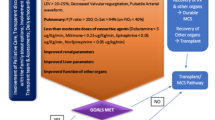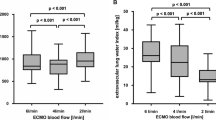Abstract
Currently, there is a lack of methods for simultaneous assessment of readiness for decannulation of the veno-venous (V-V) and veno-arterial (V-A) components during veno-arteriovenous (V-AV) extracorporal membrane oxygenation (ECMO) support. We describe a novel approach using a simultaneous off-sweep and controlled backflow test to assess readiness for decannulation from V-AV ECMO. This method needs testing in future clinical trials.
Similar content being viewed by others
V-AV ECMO is a configuration for extracorporeal life support (ECLS) in combined heart and lung failure [1]. Although numerous methods have been described to assess readiness for decannulation from veno-arterial (V-A) ECMO and veno-venous (V-V) ECMO, there is a lack of methods for simultaneous assessment of the V-V and V-A components during V-AV ECMO support.
Readiness for decannulation from V-A ECMO can be evaluated through a controlled backflow trial, which creates an artificial A-V fistula through the ECMO circuit [2, 3]. Decannulation readiness from V-V ECMO can be assessed via an off-sweep trial, thereby eliminating respiratory support. V-A support is regarded as a contraindication for an off-sweep trial because it would result in the so-called inverse Harlequin phenomenon by providing only deoxygenated blood to the lower body circulation through the arterial cannula.
We propose that readiness for decannulation from V-AV ECMO can be assessed through a simultaneous A-V backflow and off-sweep test. We describe how this test can be performed using the Maquet Cardiohelp device (Getinge, Rastatt, Germany). To conduct the test, ECMO flow should be reduced to a minimal total flow of approximately 2.5 L/min to prevent clotting in low-flow conditions. The settings for rotations per minute will be maintained at that constant value for the entire procedure. After reducing ECMO flow, the flow sensor is applied to the arterial line. Then, the adjustable clamp of the venous return line is opened until the flow in the arterial line reverses. By opening the adjustable clamp, the flow in the venous return line increases and the pressure in the venous return line decreases. Once the pressure falls below the mean arterial pressure, the flow in the arterial line reverses. To avoid the ECMO device switching to backflow prevention mode, the flow sensor should now be rotated 180 degrees to align with the outflow direction from the artery. The venous return line of the V-V component is further opened to allow a reverse flow in the arterial line of approximately 5 mL/kg/min. The setup now corresponds to a regular backflow test (Fig. 1). The backflow test assesses if the patient tolerates the removal of circulatory support and provides an additional load to the right ventricle. Since there is no flow from the ECMO to the arterial circulation at this time, the sweep can be turned off to enable a simultaneous off-sweep trial. In this configuration there is neither respiratory nor circulatory support, so a global weaning assessment is possible.
We believe this test is appropriate for a highly selected subgroup of patients with initially severe pathology (e.g., patients undergoing extracorporeal cardiopulmonary resuscitation (ECPR) with concomitant acute pulmonary pathology) that has been fully reversed. In this subgroup, our proposed algorithm allows for a rapid assessment of readiness for decannulation and, therefore, prompt and complete removal of the device, thus minimizing the inherent risks of ECMO. If the timing of improvement of respiratory and circulatory failure differs, the simultaneous weaning assessment as described above may multiply the risk of weaning failure.
To test our hypothesis, that the above described configuration allows for a more rapid assessment of readiness for decannulation, this approach could be tested in a clinical trial against a previously described stepwise approach [1] after the safety of our configuration has been assessed in observational trials or case series. At the moment, there is no scientific evidence to support the weaning strategy we described.
Availability of data and materials
Not applicable.
Abbreviations
- ECMO:
-
Extracorporal membrane oxygenation
- V-V:
-
Veno-venous
- V-A:
-
Veno-arterial
- V-AV:
-
Veno-arteriovenous
- ECLS:
-
Extracorporal life support
- ECPR:
-
Extracorporal cardiopulmonary resuscitation
References
Cakici M, Gumus F, Ozcinar E et al (2018) Controlled flow diversion in hybrid venoarterial-venous extracorporeal membrane oxygenation. Interact Cardiovasc Thorac Surg 26(1):112–118. https://doi.org/10.1093/icvts/ivx259
Lee SY, Ju M, Kim J (2020) Back flow arteriovenous shunt test for weaning of venoarterial extracorporeal membrane oxygenator. J Heart Lung Transplant 39(4):S101. https://doi.org/10.1016/j.healun.2020.01.954
Mattke CA, Haisz E, Pandya N, Black A, Venugopal P (2017) Creating a controlled arterio-venous shunt by reversing the extracorporeal membrane oxygenation blood flow: a strategy for weaning patients off veno-arterial extracorporeal membrane oxygenation. Pediatr Crit Care Med 18(10):973–976. https://doi.org/10.1097/PCC.0000000000001274
Acknowledgements
None.
Funding
No funding received.
Author information
Authors and Affiliations
Contributions
JH developed the original hypothesis. DR made substantial contributions to the conception. JH, AH, MO, TS and DR have drafted and substantially revised the work. All authors have approved the submitted version and have agreed both to be personally accountable for the author’s own contributions and to ensure that questions related to the accuracy or integrity of any part of the work, even ones in which the author was not personally involved, are appropriately investigated, resolved, and the resolution documented in the literature.
Corresponding author
Ethics declarations
Ethics approval and consent to participate
Not applicable.
Consent for publication
Not applicable.
Competing interests
JH, AH, MO, TS report no conflict of interest. DR receives a salary from Springer Verlag, Heidelberg, for having authored a book on ECMO, which is unrelated to the current publication.
Additional information
Publisher's Note
Springer Nature remains neutral with regard to jurisdictional claims in published maps and institutional affiliations.
Rights and permissions
Open Access This article is licensed under a Creative Commons Attribution 4.0 International License, which permits use, sharing, adaptation, distribution and reproduction in any medium or format, as long as you give appropriate credit to the original author(s) and the source, provide a link to the Creative Commons licence, and indicate if changes were made. The images or other third party material in this article are included in the article's Creative Commons licence, unless indicated otherwise in a credit line to the material. If material is not included in the article's Creative Commons licence and your intended use is not permitted by statutory regulation or exceeds the permitted use, you will need to obtain permission directly from the copyright holder. To view a copy of this licence, visit http://creativecommons.org/licenses/by/4.0/.
About this article
Cite this article
Heymer, J., Hein, A., Ott, M. et al. Weaning assessment of veno-arteriovenous (V-AV) extracorporeal membrane oxygenation (ECMO). ICMx 11, 47 (2023). https://doi.org/10.1186/s40635-023-00538-y
Received:
Accepted:
Published:
DOI: https://doi.org/10.1186/s40635-023-00538-y





